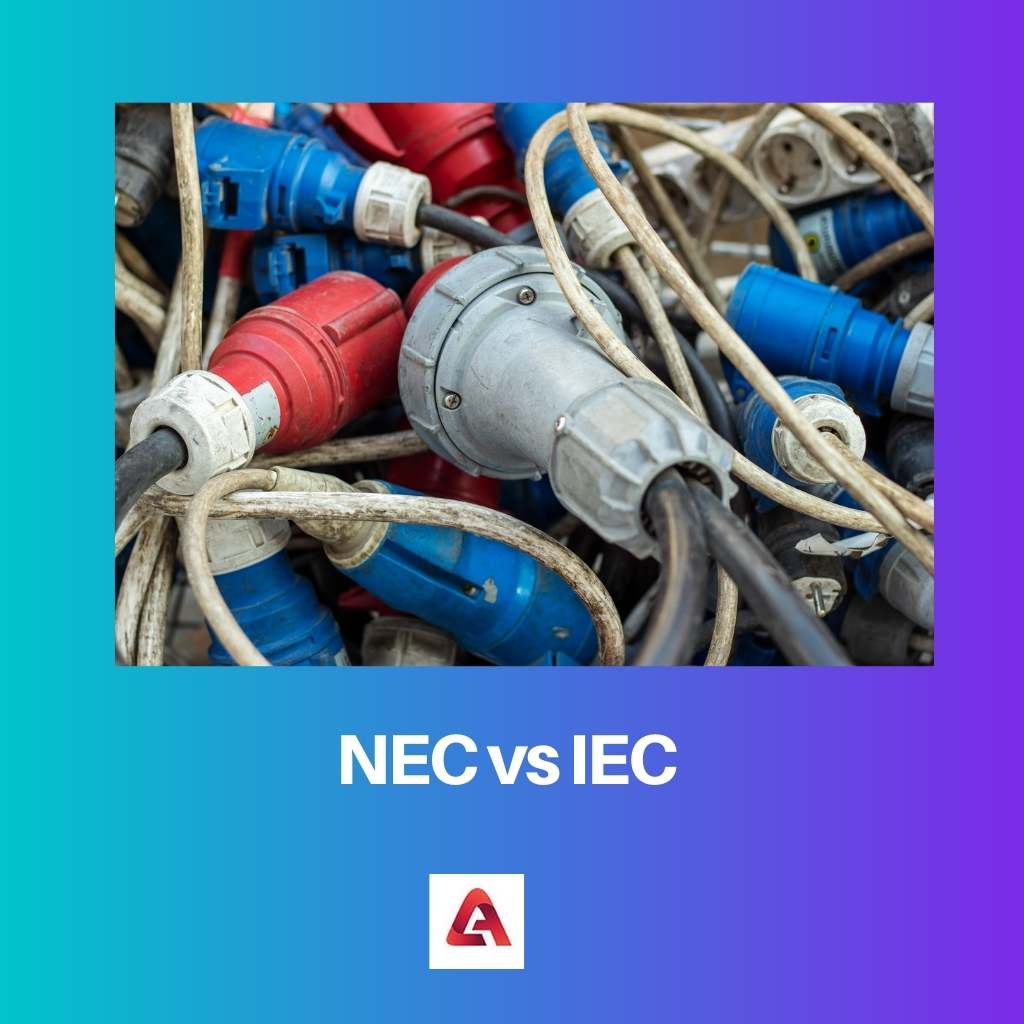The changing technology and digitalization need to be organized and maintained principles, guidance, and security for further development. Technology is seen as a prominent factor in a country’s progress, so therefore it needs to be maintained as well.
One of the practical solutions is NEC and IEC. NEC’s primary work is to provide security, while IEC’s primary work is guidance. However, NEC is much safer than IEC.
Key Takeaways
- NEC (National Electrical Code) sets the standards for electrical installations and safety in the United States.
- IEC (International Electrotechnical Commission) develops international electrical, electronic, and related technologies standards.
- NEC focuses on regional regulations, whereas IEC aims to harmonize global electrical standards and practices.
NEC vs IEC
The NEC primarily focuses on electrical safety standards for installations in the United States.IEC controls international standards in many countries worldwide. The NEC is enforced by local and state governments in the US, while national and regulatory bodies worldwide may adopt IEC standards.

NEC is a solution for organizing technology and electrical management in the US. It was issued by NFPA.
Besides, it was developed to maintain the organization with the continuously changing technology by the standard installation of the electrical system. And its primary goal is to provide safety.
Moreover, it is appropriate as a model code document, thus, it has everything to support itself. Lastly, it is seen as a much safer solution.
IEC is also a solution for organizing technology and electrical management in the US. The International Electrotechnical Commission issued it.
Besides, it was developed to guide authorities in developing national wiring principles. And its primary goal is to provide guidance.
Moreover, it is not appropriate as a model code document as it doesn’t have all the supporting documents and uniformity. Lastly, it is seen as a much more risky solution.
Comparison Table
| Parameters of comparison | NEC | IEC |
|---|---|---|
| Significant goal | NEC’s significant goal is to provide safety. | IEC’s primary goal is to guide only. |
| Developed | NEC was established by the US. | IEC is developed in Europe, thus following European concepts and regulations. |
| Requires supporting document | NEC has all things to support themselves. | IEC requires additional supporting documents and uniformity. |
| Safer | NEC works are safer. | IEC works can be risky. |
| Appropriate | NEC is appropriate as a model code document. | IEC is not. |
What is NEC?
A country is developed with the use of technology and digitalization.
So, investing in technology and advancing digitalization is necessary. Besides, the development and success of a country are measured by investment in technology and advanced digitalization.
So, a country can use techs and machinery without proper management, organization, and set standards to use it for public or government work.
Therefore, NEC was developed for the organization of technology and electronic management, especially in the United States. National Fire Protection Association NFPA issued it.
The main reason behind establishing NEC was the requirement of North America for a stable electrical system. It ultimately led to the standard installation, which was required due to the continuous advancement of machinery and digitalization.
So, NEC was developed mainly due to the needs of North America, and it evolved with the advancing machinery and digitalization.
It contains its language for further designing and installing electronics while safety standards are being met.
Apparently, NEC is adopted not only by the United States but also by Mexico, Costa Rica, Venezuela, and Columbia for an organized installation.
Besides, its primary goal is to provide safety. Moreover, it is appropriate as a model code document, thus, it has everything to support itself. Lastly, it is seen as a much safer solution.
What is IEC?
As already mentioned, a country is developed with the use of technology and digitalization. So, investing in technology and advancing digitalization is necessary.
Besides, the development and success of a country are measured by investment in technology and advanced digitalization.
Therefore, IEC was developed for the organization of technology and electronic management along with guidance. International Electrotechnical Commission issued it.
The main reason behind establishing IEC was the requirement of Europe for a stable electrical system. In 1969 in Europe, there was a failure to maintain installation requirements resulting in irreversible differences.
So, IEC was developed mainly due to the needs of Europe, and it evolved with the advancing machinery and digitalization.
IEC doesn’t have a model code document as NEC, thus, it is not suitable in many aspects. Also, the use of IEC can be risky as it doesn’t focus on overcurrent protection. However, NEC does provide overcurrent protection.
There’s always a requirement for the compatible document in IEC by engineers to have a foolproof installation.
Besides, it was developed to guide authorities in developing national wiring principles. And its primary goal is to provide guidance.
Moreover, it is not appropriate as a model code document as it doesn’t have all the supporting documents and uniformity. Lastly, it is seen as a much more risky solution.
Main differences between NEC and IEC
The technology and electronic management and organization in a country require set standards of security and guidance to develop national wiring principles as well as security from hazardous situations.
One of the practical solutions is NEC and IEC, however, they differ a lot in most aspects.
- NEC’s significant goal is to provide safety. Meanwhile, IEC’s primary goal is to guide only.
- United States established NEC, while IEC was developed in Europe, thus following European concepts and regulations.
- NEC has all things to support itself, while IEC requires additional supporting documents and uniformity.
- NEC works are safer, while IEC works can be risky.
- NEC is worthy as a model code document, while IEC is not.




